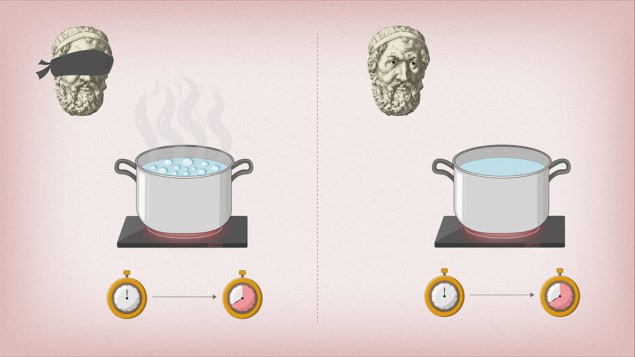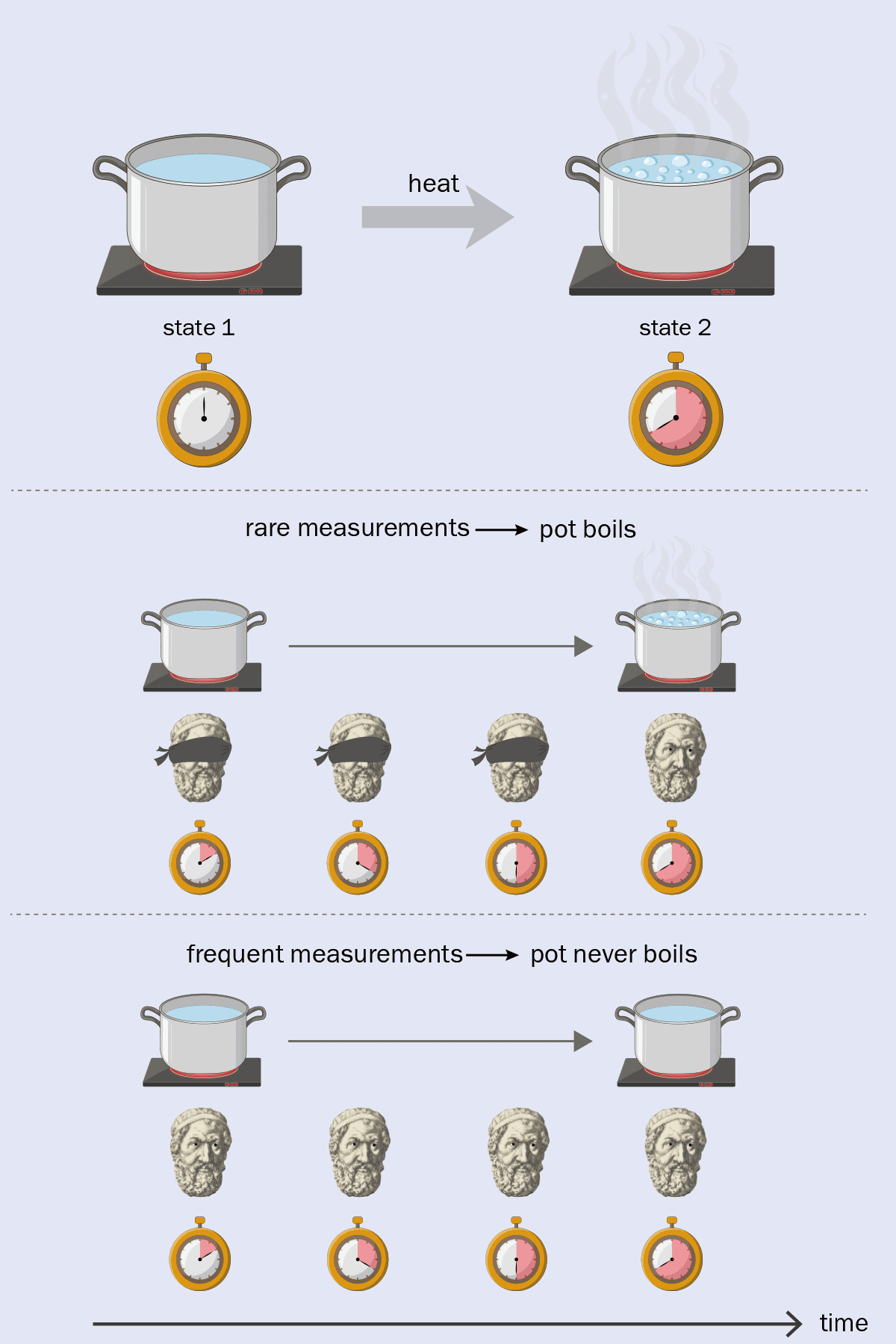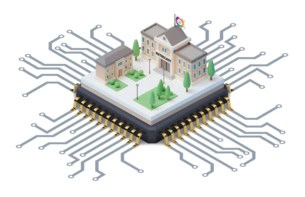
Part of our International Year of Quantum Science and Technology coverage
For the International Year of Quantum Science and Technology, Physics World is shining a spotlight on quantum effects so “weird” they make superposition and entanglement seem almost ordinary. In the first of this series, Margaret Harris sets her sights on the quantum Zeno effect

Imagine, if you will, that you are a quantum system. Specifically, you are an unstable quantum system – one that would, if left to its own devices, rapidly decay from one state (let’s call it “awake”) into another (“asleep”). But whenever you start to drift into the “asleep” state, something gets in the way. Maybe it’s a message pinging on your phone. Maybe it’s a curious child peppering you with questions. Whatever it is, it jolts you out of your awake–asleep superposition and projects you back into wakefulness. And because it keeps happening faster than you can fall asleep, you remain awake, diverted from slumber by a stream of interruptions – or, in quantum terms, measurements.
This phenomenon of repeated measurements “freezing” an unstable quantum system into a particular state is known as the quantum Zeno effect (figure 1). Named after a paradox from ancient Greek philosophy, it was hinted at in the 1950s by the scientific polymaths Alan Turing and John von Neumann but only fully articulated in 1977 by the physicists Baidyanath Misra and George Sudarshan (J. Math. Phys. 18 756). Since then, researchers have observed it in dozens of quantum systems, including trapped ions, superconducting flux qubits and atoms in optical cavities. But the apparent ubiquitousness of the quantum Zeno effect cannot hide the strangeness at its heart. How does the simple act of measuring a quantum system have such a profound effect on its behaviour?
A watched quantum pot
“When you come across it for the first time, you think it’s actually quite amazing because it really shows that the measurement in quantum mechanics influences the system,” says Daniel Burgarth, a physicist at the Friedrich-Alexander-Universität in Erlangen-Nürnberg, Germany, who has done theoretical work on the quantum Zeno effect.
Giovanni Barontini, an experimentalist at the University of Birmingham, UK, who has studied the quantum Zeno effect in cold atoms, agrees. “It doesn’t have a classical analogue,” he says. “I can watch a classical system doing something forever and it will continue doing it. But a quantum system really cares if it’s watched.”
1 A watched quantum pot

Applying heat to a normal, classical pot of water will cause it to evolve from state 1 (not boiling) to state 2 (boiling) at the same rate regardless of whether anyone is watching it (even if it doesn’t seem like it). In the quantum world, however, a system that would normally evolve from one state to the other if left unobserved (blindfolded Zeno) can be “frozen” in place by repeated frequent measurements (eyes-open Zeno).
For the physicists who laid the foundations of quantum mechanics a century ago, any connection between measurement and outcome was a stumbling block. Several tried to find ways around it, for example by formalizing a role for observers in quantum wavefunction collapse (Niels Bohr and Werner Heisenberg); introducing new “hidden” variables (Louis de Broglie and David Bohm); and even hypothesizing the creation of new universes with each measurement (the “many worlds” theory of Hugh Everett).
But none of these solutions proved fully satisfactory. Indeed, the measurement problem seemed so intractable that most physicists in the next generation avoided it, preferring the approach sometimes described – not always pejoratively – as “shut up and calculate”.
Today’s quantum physicists are different. Rather than treating what Barontini calls “the apotheosis of the measurement effect” as a barrier to overcome or a triviality to ignore, they are doing something few of their forebears could have imagined. They are turning the quantum Zeno effect into something useful.
Noise management
To understand how freezing a quantum system by measuring it could be useful, consider a qubit in a quantum computer. Many quantum algorithms begin by initializing qubits into a desired state and keeping them there until they’re required to perform computations. The problem is that quantum systems seldom stay where they’re put. In fact, they’re famously prone to losing their quantum nature (decohering) at the slightest disturbance (noise) from their environment. “Whenever we build quantum computers, we have to embed them in the real world, unfortunately, and that real world causes nothing but trouble,” Burgarth says.
Quantum scientists have many strategies for dealing with environmental noise. Some of these strategies are passive, such as cooling superconducting qubits with dilution refrigerators and using electric and magnetic fields to suspend ionic and atomic qubits in a vacuum. Others, though, are active. They involve, in effect, tricking qubits into staying in the states they’re meant to be in, and out of the states they’re not.
The quantum Zeno effect is one such trick. “The way it works is that we apply a sequence of kicks to the system, and we are actually rotating the qubit with each kick,” Burgarth explains. “You’re rotating the system, and then effectively the environment wants to rotate it in the other direction.” Over time, he adds, these opposing rotations average out, protecting the system from noise by freezing it in place.
Quantum state engineering
While noise mitigation is useful, it’s not the quantum Zeno application that interests Burgarth and Barontini the most. The real prize, they agree, is something called quantum state engineering, which is much more complex than simply preventing a quantum system from decaying or rotating.
The source of this added complexity is that real quantum systems – much like real people – usually have more than two states available to them. For example, the set of permissible “awake” states for a person – the Hilbert space of wakefulness, let’s call it – might include states such as cooking dinner, washing dishes and cleaning the bathroom. The goal of quantum state engineering is to restrict this state-space so the system can only occupy the state(s) required for a particular application.
As for how the quantum Zeno effect does this, Barontini explains it by referring to Zeno’s original, classical paradox. In the fifth century BCE, the philosopher Zeno of Elea posed a conundrum based on an arrow flying through the air. If you look at this arrow at any possible moment during its flight, you will find that in that instant, it is motionless. Yet somehow, the arrow still moves. How?
In the quantum version, Barontini explains, looking at the arrow freezes it in place. But that isn’t the only thing that happens. “The funniest thing is that if I look somewhere, then the arrow cannot go where I’m looking,” he says. “It will have to go around it. It will have to modify its trajectory to go outside my field of view.”
By shaping this field of view, Barontini continues, physicists can shape the system’s behaviour. As an example, he cites work by Serge Haroche, who shared the 2012 Nobel Prize for Physics with another notable quantum Zeno experimentalist, David Wineland.
In 2014 Haroche and colleagues at the École Normale Supérieure (ENS) in Paris, France, sought to control the dynamics of an electron within a so-called Rydberg atom. In this type of atom, the outermost electron is very weakly bound to the nucleus and can occupy any of several highly excited states.
The researchers used a microwave field to divide 51 of these highly excited Rydberg states into two groups, before applying radio-frequency pulses to the system. Normally, these pulses would cause the electron to hop between states. However, the continual “measurement” supplied by the microwave field meant that although the electron could move within either group of states, it could not jump from one group to the other. It was stuck – or, more precisely, it was in a special type of quantum superposition known as a Schrödinger cat state.
Restricting the behaviour of an electron might not sound very exciting in itself. But in this and other experiments, Haroche and colleagues showed that imposing such restrictions brings forth a slew of unusual quantum states. It’s as if telling the system what it can’t do forces it to do a bunch of other things instead, like a procrastinator who cooks dinner and washes dishes to avoid cleaning the bathroom. “It really enriches your quantum toolbox,” explains Barontini. “You can generate an entangled state that is more entangled or methodologically more useful than other states you could generate with traditional means.”
Just what is a measurement, anyway?
As well as generating interesting quantum states, the quantum Zeno effect is also shedding new light on the nature of quantum measurements. The question of what constitutes a “measurement” for quantum Zeno purposes turns out to be surprisingly broad. This was elegantly demonstrated in 2014, when physicists led by Augusto Smerzi at the Università di Firenze, Italy, showed that simply shining a resonant laser at their quantum system (figure 2) produced the same quantum Zeno dynamics as more elaborate “projective” measurements – which in this case involved applying pairs of laser pulses to the system at frequencies tailored to specific atomic transitions. “It’s fair to say that almost anything causes a Zeno effect,” says Burgarth. “It’s a very universal and easy-to-trigger phenomenon.”
2 Experimental realization of quantum Zeno dynamics

The energy level structure of a population of ultracold 87Rb atoms, evolving in a five-level Hilbert space given by the five spin orientations of the F=2 hyperfine ground state. An applied RF field (red arrows) couples neighbouring quantum states together and allows atoms to “hop” between states. Normally, atoms initially placed in the |F, mF> = |2,2> state would cycle between this state and the other four F=2 states in a process known as Rabi oscillation. However, by introducing a “measurement” – shown here as a laser beam (green arrow) resonant with the transition between the |1,0> state and the |2,0> state – Smerzi and colleagues drastically changed the system’s dynamics, forcing the atoms to oscillate between just the |2,2> and |2,1> states (represented by up and down arrows on the so-called Bloch sphere at right). An additional laser beam (orange arrow) and the detector D were used to monitor the system’s evolution over time.
Other research has broadened our understanding of what measurement can do. While the quantum Zeno effect uses repeated measurements to freeze a quantum system in place (or at least slow its evolution from one state to another), it is also possible to do the opposite and use measurements to accelerate quantum transitions. This phenomenon is known as the quantum anti-Zeno effect, and it has applications of its own. It could, for example, speed up reactions in quantum chemistry.
Over the past 25 years or so, much work has gone into understanding where the ordinary quantum Zeno effect leaves off and the quantum anti-Zeno effect begins. Some systems can display both Zeno and anti-Zeno dynamics, depending on the frequency of the measurements and various environmental conditions. Others seem to favour one over the other.
But regardless of which version turns out to be the most important, quantum Zeno research is anything but frozen in place. Some 2500 years after Zeno posed his paradox, his intellectual descendants are still puzzling over it.
This article forms part of Physics World‘s contribution to the 2025 International Year of Quantum Science and Technology (IYQ), which aims to raise global awareness of quantum physics and its applications.
Stayed tuned to Physics World and our international partners throughout the next 12 months for more coverage of the IYQ.
Find out more on our quantum channel.




